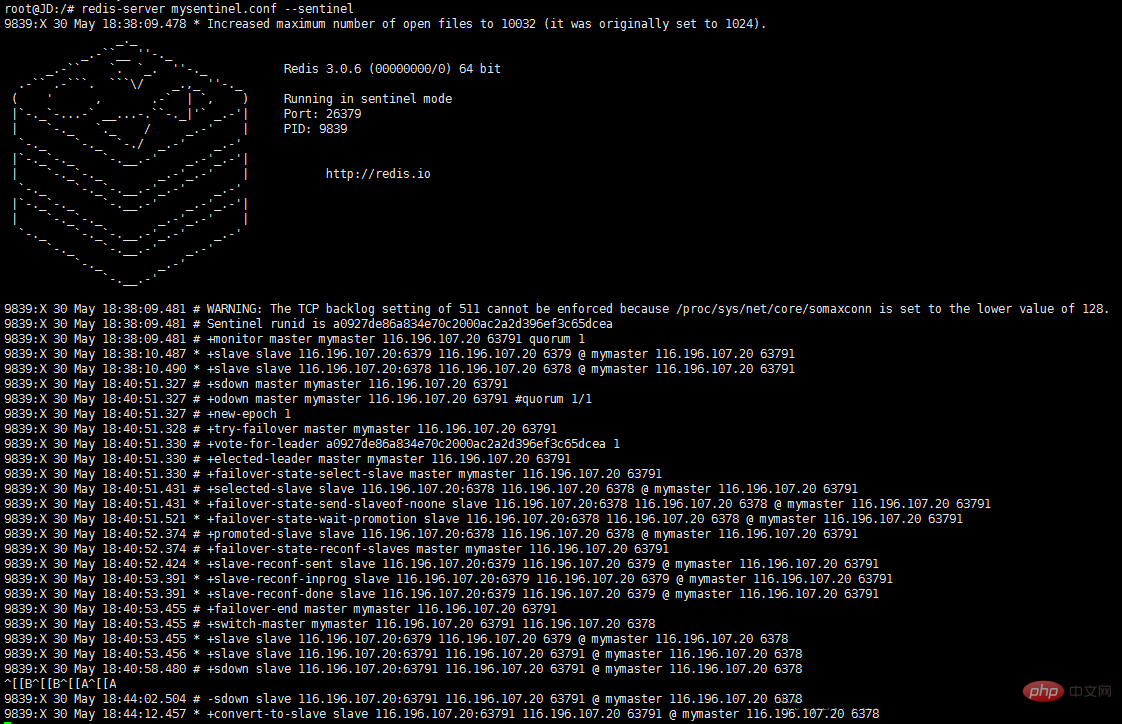Redis read-write separation and sentinel mechanism configuration

1. Use the commands cp redis.conf /redis63791.conf, cp redis.conf /redis63792.conf, cp redis.conf /redis63793.conf in /etc/redis/ to The root directory is ready
vim redis63792.conf --->修改配置文件 daemonize yes 守护进程 port 63792 端口 bind 192.168.0.3 绑定内网地址 databases 16 开启16个数据库 save ---> 每多少个文件执行一次保存 (主人不需要以下操作) slaveof 116.196.107.20 63791 --> 作为该ip该端口的奴隶 masterauth '123456789' --> 认证主人的密码 ---------------------- appendonly yes 开启这个增强数据的安全性 (以上为正常的redis.conf里面的配置文件,所有的slave都要去连接主人的服务器,只能读,不能写,自动同步数据,读写分离可以大大的增强服务器的性能能,因为在正常的数据操作中, 读的时候往往比写的时候的情况要多的多, 一般情况下主从机按1:3进行分配)
2. Sentinel configuration, find the sentinel.conf file in /etc/redis (if you don’t have such a configuration file), copy cp sentinel.conf /mysentinel .conf
vim mysentinel.conf sentinel monitor mymaster 116.196.107.20 63791 1 -->分别的意思是 哨兵监听主人:116.196.107.20的 端口:63791 哨兵数量1个, 一般情况下哨兵的数量越多, 投票选举通过的几率越小, 在投票选举出新主人花费的时间就越多, 不利于快速切换主从机制 sentinel down-after-milliseconds mymaster 5000 主机掉线以后5s进行认证,如果无法连接则重新由哨兵从slave中选出新的主人 sentinel auth-pass mymaster 123456789 哨兵通过密码连接主人
3. After the configuration is completed, you can turn on the master-slave mechanism, separate reading and writing, and provide a sentinel mechanism. After the master is down for 5 seconds, a new master will be randomly selected from the slave. Previously After the master is connected, he can only work as a slave! !
redis操作命令: redis-server redis63791.conf & -->以该配置文件在后台运行服务器 redis-cli -h 116.196.107.20 -p 63791 远程连接服务器 auth 123456789 --->在redis中验证密码 redis-server mysentinel.conf --sentinel 启动哨兵模式开始监听, 如下:

For more redis knowledge, please pay attention to the redis introductory tutorial column.
The above is the detailed content of Redis read-write separation and sentinel mechanism configuration. For more information, please follow other related articles on the PHP Chinese website!

Hot AI Tools

Undresser.AI Undress
AI-powered app for creating realistic nude photos

AI Clothes Remover
Online AI tool for removing clothes from photos.

Undress AI Tool
Undress images for free

Clothoff.io
AI clothes remover

Video Face Swap
Swap faces in any video effortlessly with our completely free AI face swap tool!

Hot Article

Hot Tools

Notepad++7.3.1
Easy-to-use and free code editor

SublimeText3 Chinese version
Chinese version, very easy to use

Zend Studio 13.0.1
Powerful PHP integrated development environment

Dreamweaver CS6
Visual web development tools

SublimeText3 Mac version
God-level code editing software (SublimeText3)

Hot Topics
 How to build the redis cluster mode
Apr 10, 2025 pm 10:15 PM
How to build the redis cluster mode
Apr 10, 2025 pm 10:15 PM
Redis cluster mode deploys Redis instances to multiple servers through sharding, improving scalability and availability. The construction steps are as follows: Create odd Redis instances with different ports; Create 3 sentinel instances, monitor Redis instances and failover; configure sentinel configuration files, add monitoring Redis instance information and failover settings; configure Redis instance configuration files, enable cluster mode and specify the cluster information file path; create nodes.conf file, containing information of each Redis instance; start the cluster, execute the create command to create a cluster and specify the number of replicas; log in to the cluster to execute the CLUSTER INFO command to verify the cluster status; make
 How to read redis queue
Apr 10, 2025 pm 10:12 PM
How to read redis queue
Apr 10, 2025 pm 10:12 PM
To read a queue from Redis, you need to get the queue name, read the elements using the LPOP command, and process the empty queue. The specific steps are as follows: Get the queue name: name it with the prefix of "queue:" such as "queue:my-queue". Use the LPOP command: Eject the element from the head of the queue and return its value, such as LPOP queue:my-queue. Processing empty queues: If the queue is empty, LPOP returns nil, and you can check whether the queue exists before reading the element.
 How to clear redis data
Apr 10, 2025 pm 10:06 PM
How to clear redis data
Apr 10, 2025 pm 10:06 PM
How to clear Redis data: Use the FLUSHALL command to clear all key values. Use the FLUSHDB command to clear the key value of the currently selected database. Use SELECT to switch databases, and then use FLUSHDB to clear multiple databases. Use the DEL command to delete a specific key. Use the redis-cli tool to clear the data.
 How to configure Lua script execution time in centos redis
Apr 14, 2025 pm 02:12 PM
How to configure Lua script execution time in centos redis
Apr 14, 2025 pm 02:12 PM
On CentOS systems, you can limit the execution time of Lua scripts by modifying Redis configuration files or using Redis commands to prevent malicious scripts from consuming too much resources. Method 1: Modify the Redis configuration file and locate the Redis configuration file: The Redis configuration file is usually located in /etc/redis/redis.conf. Edit configuration file: Open the configuration file using a text editor (such as vi or nano): sudovi/etc/redis/redis.conf Set the Lua script execution time limit: Add or modify the following lines in the configuration file to set the maximum execution time of the Lua script (unit: milliseconds)
 How to use the redis command line
Apr 10, 2025 pm 10:18 PM
How to use the redis command line
Apr 10, 2025 pm 10:18 PM
Use the Redis command line tool (redis-cli) to manage and operate Redis through the following steps: Connect to the server, specify the address and port. Send commands to the server using the command name and parameters. Use the HELP command to view help information for a specific command. Use the QUIT command to exit the command line tool.
 How to set the redis expiration policy
Apr 10, 2025 pm 10:03 PM
How to set the redis expiration policy
Apr 10, 2025 pm 10:03 PM
There are two types of Redis data expiration strategies: periodic deletion: periodic scan to delete the expired key, which can be set through expired-time-cap-remove-count and expired-time-cap-remove-delay parameters. Lazy Deletion: Check for deletion expired keys only when keys are read or written. They can be set through lazyfree-lazy-eviction, lazyfree-lazy-expire, lazyfree-lazy-user-del parameters.
 How to implement redis counter
Apr 10, 2025 pm 10:21 PM
How to implement redis counter
Apr 10, 2025 pm 10:21 PM
Redis counter is a mechanism that uses Redis key-value pair storage to implement counting operations, including the following steps: creating counter keys, increasing counts, decreasing counts, resetting counts, and obtaining counts. The advantages of Redis counters include fast speed, high concurrency, durability and simplicity and ease of use. It can be used in scenarios such as user access counting, real-time metric tracking, game scores and rankings, and order processing counting.
 How to optimize the performance of debian readdir
Apr 13, 2025 am 08:48 AM
How to optimize the performance of debian readdir
Apr 13, 2025 am 08:48 AM
In Debian systems, readdir system calls are used to read directory contents. If its performance is not good, try the following optimization strategy: Simplify the number of directory files: Split large directories into multiple small directories as much as possible, reducing the number of items processed per readdir call. Enable directory content caching: build a cache mechanism, update the cache regularly or when directory content changes, and reduce frequent calls to readdir. Memory caches (such as Memcached or Redis) or local caches (such as files or databases) can be considered. Adopt efficient data structure: If you implement directory traversal by yourself, select more efficient data structures (such as hash tables instead of linear search) to store and access directory information






